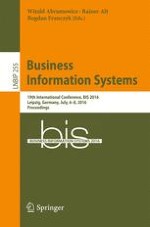This book contains the refereed proceedings of the 19th International Conference on Business Information Systems, BIS 2016, held in Leipzig, Germany, in July 2016. The BIS conference series follows trends in academia and business research; thus the theme of the BIS 2016 conference was Smart Business Ecosystems". This recognizes that no business is an island and competition is increasingly taking place between business networks and no longer between individual companies. A variety of aspects is relevant for designing and understanding smart business ecosystems. They reach from new business models, value chains and processes to all aspects of analytical, social and enterprise applications and platforms as well as cyber-physical infrastructures.
The 33 full and 1 short papers were carefully reviewed and selected from 87 submissions. They are grouped into sections on ecosystems; big and smart data; smart infrastructures; process management; business and enterprise modeling; service science; social media; and applications.
